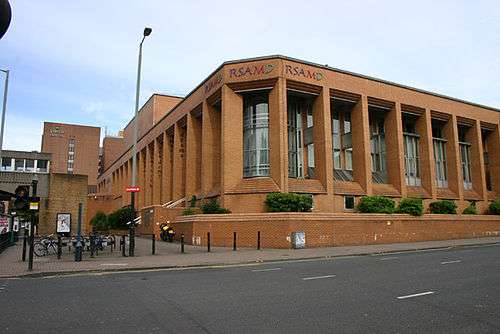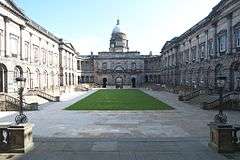Royal Conservatoire of Scotland
|
Scottish Gaelic: Conservatoire Rìoghail na h-Alba | |
 Front facade of the Conservatoire. | |
| Type | Conservatoire |
|---|---|
| Established |
1993 - granted degree-awarding powers 1845 - Glasgow Educational Association |
| President | Sir Cameron Mackintosh |
| Principal | Jeffrey Sharkey |
| Students | 1,155 (2016/17)[1] |
| Undergraduates | 845 (2016/17)[1] |
| Postgraduates | 310 (2016/17)[1] |
| Location | Glasgow, Scotland, UK |
| Colours | |
| Affiliations | Conservatoires UK, Associated Board of the Royal Schools of Music, University of St Andrews, Association of European Conservatoires, Conference of Drama Schools |
| Website | rcs.ac.uk |
 | |
The Royal Conservatoire of Scotland, (Scottish Gaelic: Conservatoire Rìoghail na h-Alba) formerly the Royal Scottish Academy of Music and Drama, is a conservatoire of dance, drama, music, production and film in the centre of Glasgow, Scotland. It is one of the oldest and most prestigious performing arts schools in the United Kingdom,[2] and ranked third in the world as of 2017.[3] Founded in 1845 as the Glasgow Educational Association, it is the busiest performing arts venue in Scotland with over 500 public performances each year.
The current Principal is American pianist and composer Jeffrey Sharkey, the President is Sir Cameron Mackintosh, and the Patron is HRH The Duke of Rothesay.
History
The Royal Conservatoire has occupied its current purpose-built building on Renfrew Street in Glasgow since 1988. Its roots lie in several different organisations. It began with the establishment of the Glasgow Educational Association in 1845, which formed to provide courses in competition with the University of Glasgow. The Association later became the Glasgow Commercial College, and this in turn became part of the Glasgow Athenaeum in 1847. The Glasgow Athenaeum provided training in commercial skills, literature, languages, sciences, mathematics and music. Charles Dickens gave its inaugural speech, in which he stated that he regarded the Glasgow Athenaeum as "an educational example and encouragement to the rest of Scotland".
In 1888, the commercial teaching of the Glasgow Athenaeum separated to form the Athenaeum Commercial College, which, after several rebrandings and a merger, became the University of Strathclyde in 1964. In 1890 the non-commercial teaching side of the Glasgow Athenaeum became the Glasgow Athenaeum School of Music. In 1928 the premises were extended with a gift from the philanthropist Daniel Macaulay Stevenson. In 1929 the school was renamed as the Scottish National Academy of Music to better reflect its scope and purpose.[4] Its first Principal from 1929–1941 was William Gillies Whittaker. In 1944, it became the Royal Scottish Academy of Music.
The Royal Scottish Academy of Music established a drama department called the Glasgow College of Dramatic Art during 1950. It became the first British drama school to contain a full, broadcast-specification television studio in 1962. In 1968 the Royal Scottish Academy of Music changed its name to the Royal Scottish Academy of Music and Drama (RSAMD) and introduced its first degree courses, which were validated by the University of Glasgow.
In 1993 RSAMD became the first conservatoire in the United Kingdom to be granted its own degree-awarding powers. Research degrees undertaken at RSAMD are validated and awarded by the University of St Andrews in Fife.[5] RSAMD is one of four member conservatories of the Associated Board of the Royal Schools of Music.
Name change
From 1 September 2011, the RSAMD changed its name to the Royal Conservatoire of Scotland.[6] They decided on the name change after a long consultation process that involved the principal and the Academy's board of directors, as well as past and present students and staff, arts & academic institutions, politicians, and the Royal Protocol Unit.
Principal John Wallace said the new name was necessary to cover all fields that the institute offers, as it no longer is simply a music and drama academy. Undergraduate courses in areas such as Digital Film & Television, Production Arts and Design, Production Technology and Management, Musical Theatre and Modern Ballet (in partnership with Scottish Ballet) have been added to the degrees the Royal Conservatoire offers. The Principal felt it was best to choose a name that was representative of all disciplines offered.[7]
In 2016 & 2017, QS Quacquarelli Symonds ranked it as one of the world's best institutions for Performing Arts in their global ranking of the discipline.[8]
Facilities
The Royal Conservatoire has a range of facilities, including several performance spaces: the Ledger Room, Stevenson Hall, the Chandler Studio Theatre, the New Athenaeum Theatre, and the Alexander Gibson Opera Studio (built in 1998). There are around 65 private practice rooms for music students, each equipped with a piano with stool, music stand and chairs. These include 11 rooms reserved solely for pianists, several rooms for use by the Scottish Music department, and 8 rehearsal and coaching rooms. The Royal Conservatoire also houses several professional recording studios, including a new studio in the Opera School for the use of large ensembles.
The Royal Conservatoire also has an automated flying system in its main performing venue, the New Athenaeum Theatre, meaning it has become the first educational establishment in the UK to offer Stage Automation Training as part of the curriculum.
In 2010, RCS opened its second campus near Cowcaddens, now known as the "Wallace Studios at Speirs Locks".[9] This building was designed by Malcolm Fraser. It opened predominantly to house the Modern Ballet and Production courses, as the Renfrew Street campus was struggling to accommodate the combination of new courses and higher intake levels. In 2014, a £2 million extension to this second campus was built, creating even more rehearsal spaces and improved facilities for the students.
The Royal Conservatoire's extensive archive of historical papers and ephemera charts both its own institutional history and the wider performance history of Scotland.
Schools
School of Music
- Brass
- Chamber Music
- Composition
- Conducting
- Education
- Guitar and Harp
- Historically Informed Performance Practice
- Jazz
- Keyboard
- Opera
- Piano Accompaniment
- Piano for Dance
- Repetiteurship
- Scottish Music
- Strings
- Timpani and Percussion
- Traditional Music
- Traditional Music - Piping
- Vocal Studies
- Woodwind
School of Drama, Dance, Production and Film
- Acting
- Classical and Contemporary Text (Masters)
- Contemporary Performance Practice
- Filmmaking
- Performance in British Sign Language and English
- Production Arts and Design
- Production Technology and Management
- Musical Theatre
- Musical Theatre Performance or Musical Directing or Choreography (Masters)
- Modern Ballet
Junior Conservatoire
- Junior Conservatoire of Music
- Junior Conservatoire of Acting
- Junior Conservatoire of Production
- Junior Conservatoire of Film
- Junior Conservatoire of Dance
- Junior Conservatoire of Musical Theatre
Alumni
- Ani Batikian
- Maureen Beattie
- Cora Bissett
- Iain Blair
- Christine Bottomley
- Billy Boyd
- Betsy Brandt
- Alison Brie
- Jack Bruce
- Isobel Buchanan
- Stuart Cassells
- Karen Cargill
- John Carlin
- Robert Carlyle
- Carrie Cracknell
- Tom Conti
- Nicholas Cowell
- Amy Conachan[10]
- Damian Cruden
- Alan Cumming
- Tony Curran
- Henry Ian Cusick
- Louise Delamere
- Kate Dickie
- Laura Donnelly
- Patrick Doyle
- Christopher Duncan
- Sheena Easton
- Valerie Edmond
- Emun Elliott
- Lynn Ferguson
- Emma Fielding
- James Fleet
- Laura Fraser
- Alexander Gibson
- Michelle Gomez
- Stella Gonet
- Hannah Gordon
- Kevin Guthrie
- John Hannah
- David Hayman
- Ivan Heng
- Jeremy Herrin
- Sam Heughan
- Aneirin Hughes
- Tunji Kasim
- Colin Lamont
- Denis Lawson
- Katie Leung
- Phyllis Logan
- Angela Lonsdale
- Jack Lowden
- Shauna Macdonald
- Richard Madden
- Rik Makarem
- Lauren Marcus
- Mary Marquis
- Angus MacPhail
- James McAvoy
- Colin McCredie
- Ian McDiarmid
- Greg McHugh
- David McVicar
- Anthony Michaels-Moore
- Aleksander Mikic
- Colin Morgan
- Paul Leonard-Morgan
- Daniela Nardini
- Gray O'Brien
- Kevin O'Loughlin
- Ian Parker
- Bill Paterson
- Shernaz Patel
- Margaret Preece
- Jenna Reid
- Ian Richardson
- Natalie J. Robb
- Anne Sharp
- Sean Shibe
- Alexandra Silber
- Elaine C Smith
- Dawn Steele
- Andrew Stevenson
- David Tennant
- Emily Smith
- Brian Vernel
- Dougie Vipond
- Jonathan Watson
- Ruby Wax
- Julie Wilson Nimmo
- Greg Wise
- Jayne Wisener
See also
References
- 1 2 3 "2016/17 Students by HE provider, level, mode and domicile" (CSV). Higher Education Statistics Agency. Retrieved 25 March 2018.
- ↑ "QS World University Rankings by Subject 2016 - Performing Arts". Top Universities. QS Quacquarelli Symonds. Retrieved 14 September 2016.
- ↑ "QS World University Rankings by Subject 2017 - Performing Arts". Top Universities. QS Quacquarelli Symonds. Retrieved 14 September 2017.
- ↑ "Extension of premises". The Glasgow Herald. 9 June 1928. Retrieved 14 August 2016.
- ↑ University of St Andrews - Royal Conservatoire of Scotland
- ↑ RSAMD renaming Archived 30 April 2011 at the Wayback Machine.
- ↑ Tumelty, Michael (4 July 2011). "Change the academy's name, but not its soul". Herald Scotland. Retrieved 14 August 2016.
- ↑ "QS World University Rankings by Subject 2016 - Performing Arts". Top Universities. QS Quacquarelli Symonds. Retrieved 14 September 2016.
- ↑ Speirs Locks Studios
- ↑ "Amy Conachan: Starring in a disability sex comedy". BBC News. 18 March 2014. Retrieved 8 February 2018.
External links
![]()

